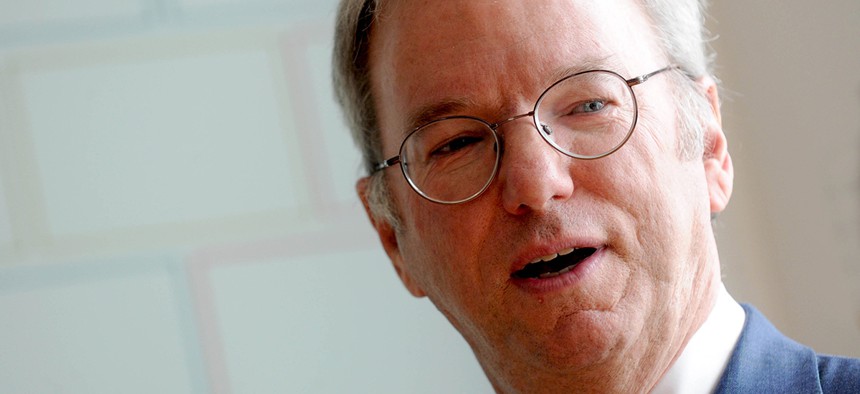Hacked Emails Show Eric Schmidt Played Crucial Role in Team Hillary’s Election Tech

Alphabet Chairman Eric Schmidt Dennis Van Tine/STAR MAX/AP
Schmidt leveraged his Silicon Valley acumen to generate a new source of influence.
“I met with Eric Schmidt tonight,” John Podesta, the longtime Hillary Clinton adviser, told campaign manager-in-waiting Robby Mook in April 2014, more than a year before Clinton announced her candidacy for president.
The email, stolen by Russian hackers and published by WikiLeaks, details the billionaire Alphabet chairman’s interest in backing Hillary Clinton’s nascent presidential run:
“He’s ready to fund, advise recruit talent, etc. He was more deferential on structure than I expected. Wasn’t pushing to run through one of his existing firms. Clearly wants to be head outside advisor, but didn’t seem like he wanted to push others out. Clearly wants to get going. He’s still in DC tomorrow and would like to meet with you if you are in DC in the afternoon. I think it’s worth doing.”
What did the meeting lead to? As of this week, Schmidt hasn’t bothered to donate a cent directly to Clinton’s campaign. Instead, he has leveraged his Silicon Valley acumen to generate a new source of influence.
Start-ups for Hillary
Schmidt donated $5,000 to Barack Obama’s 2012 campaign and advised it on digital operations; afterward, he invested in several start-ups founded by talented engineers and analysts who worked for the campaign, and had developed new ways to use campaign data to improve advertising and voter-turnout operations.
One of those firms, The Groundwork, is now the Clinton campaign’s top technology vendor, earning more than $600,000 in fees since the campaign began, according to federal campaign finance disclosures. Last year, Quartz reported on the Groundwork’s stealthy role in developing a technology platform that would develop the infrastructure to manage the campaign’s data and tools to engage voters.
Now, with emails stolen from Podesta’s email account by Russian hackers available on the internet, we have more clues to how Schmidt contributed to Clinton’s use of election tech.
(Her campaign refused to confirm the accuracy of any of these emails or comment for this story; Schmidt did not reply to an email seeking comment.)
Podesta meets Schmidt
Podesta is a longtime Democratic insider. Schmidt is the billionaire technology executive who became Barack Obama’s primary link to Silicon Valley’s boardrooms. Their first 2014 meeting confirms that Schmidt was involved discussions of the campaign’s strategy from the get-go.
At the time Podesta and Schmidt met, Clinton’s core staff were discussing how her online infrastructure could seamlessly move from an exploratory committee to a full-fledged campaign when the time was right.
“The thing he really pressed me hard on was geography,” Podesta wrote of their meeting. “Very committed to the idea that this be done in a city where young coders would want to be, preferably outer borough NYC. Thought No Cal was priced out of the market and too into itself. Thought DC lacked talent in this arena.”
Schmidt’s strategy memo
Two weeks later, Schmidt sent a memo to Clinton aide Cheryl Mills outlining his ideas for the campaign.
“Lets assume a total budget of about $1.5Billion, with more than 5000 paid employees and million(s) of volunteers,” he began. “The entire startup ceases operation four days after November 8, 2016.” Much of the memo’s content would have been old hat to other staffers who saw it: Podesta, Mook and David Plouffe, the veteran Obama operative.
But Schmidt’s outline gave clues to the basic tech challenges he foresaw building on Obama’s 2012 effort. Clinton, he said, would need to push vendors and her staff to move their technology to the cloud so it would scale more easily and to avoid expensive investments in servers. And he saw the need for new tools to integrate the various data sets—voter files, social media profiles, cable box records—into one system.
“Key is the development of a single record for a voter that aggregates all that is known about them,” he wrote. “In 2016 smart phones will be used to identify, meet, and update profiles on the voter….[q]uite a bit of software is to be developed to match digital identities with the actual voter file with high confidence.”
Schmidt also recognized concerns—voiced by others in the campaign, and common in the world of high-dollar political consulting—that vendors would seek to exploit the campaign for financial gain.
“Its important that all the player in the campaign work at cost and there be no special interests in the financing structure,” Schmidt wrote, proposing audits to ensure no one was earning money on the sly. “The rules of the audit should include caps on individual salaries and no investor profits from the campaign function. (For example, this rule would apply to me.)”
Laying the Groundwork
The Groundwork was formed as a Delaware LLC with Schmidt’s backing two months later, in June 2014. As Schmidt advised, its offices were in Brooklyn, blocks from the building that would eventually house Clinton’s campaign headquarters. The company’s leader. Michael Slaby, had been one of Obama’s top digital staffers in 2012. (He did not respond to a request for comment on this story.)
Slaby hired top engineers from companies like Netflix and Google to build the unsexy but critical back-end infrastructure for signing up supporters and collecting donations, with plans to market the platform to corporate clients through the Groundwork’s parent company, Timshel, also backed by Schmidt.
“There are a lot of people who can write big checks,” Slaby told Quartz last year. “Eric recognizes how the technology he’s been building his whole career can be applied to different spaces. The idea of tech as a force multiplier is something he deeply understands.”
Slaby would not be the only talent Schmidt helped bring to the campaign. The campaign’s influential chief technology officer, Stephanie Hannon, is a veteran Google engineer. Civis, another company founded by former Obama staffers and funded by Schmidt, has provided some media analytics for the campaign.
Sometimes, the recruiting efforts fell flat. Mook wrote to Podesta the same month the Groundwork was founded, asking him to call Mikey Dickerson, a former Google technologist who worked on Obama’s campaign and then parachuted in to Washington to help rescue HealthCare.gov when the website floundered.
“We are desperately trying to get him to oversee the Eric Schmidt project,” Mook wrote.”He’s apparently open to doing it but a little worried about how legit it is and what it means for later on. I was hoping you could call him to tell him how important the project is and how much faith higher ups would have in his ability to deliver a really good product…and how that would inevitably mean a position later.”
Their effort failed; Dickerson is currently employed at the U.S. Digital Service, which bills itself as “a startup at the White House” that works to bring the best technology and practices to government agencies.
Hillary’s AI curiosity
At some point, Schmidt met with Clinton herself to discuss the effort. The candidate had at least some interest in the nuts and bolts of her campaign’s technology, requesting updates on her website ahead of her candidacy’s launch and at one point e-mailing her team to ask about Facebook’s decision to open-source artificial intelligence technology. (The answer, attributed to her campaign digital director Teddy Goff, was that “AI may be more 2020 than 2016.”)
Schmidt also requested a meeting with former President Bill Clinton in February 2015. “[I]t is about the business [Schmidt] proposes to do with the campaign,” Tina Flournoy, Bill Clinton’s chief of staff, wrote. “He says he’s met with HRC.” “Yup,” Podesta replies. “I’ve talked to him too. Robby is in touch with his team.”
Flournoy also mentioned Google was lending its corporate jet to fly the former president to Africa that summer as part of a Clinton Foundation trip, with the two joking about previous times it had broken down.
It’s all “gravy”
It’s not clear today how much value the Groundwork’s tools ultimately provided to the campaign; some Democratic sources suggest the internal tools developed by Hannon’s team have solved problems the Groundwork once x`aspired to tackle. For all its success, Obama’s 2012 technology team lacked a cohesive management structure, and returning staffers wanted to avoid siloed teams or campaign officials who felt outranked by better-paid vendors.
“Imagine you’re a mid-level person inside the campaign, or even the campaign manager,” one veteran Democratic operative said last year. “Who’s going to say, ‘Hey, billionaire smartest tech guy on the planet, thanks but no thanks?’”
In October 2014, a draft memo on digital strategy written by Mook for Hillary Clinton discusses “Eric Schmidt’s company Groundwork,” then a 10-person team developing a dynamic sign-up page and donation tool to be deployed by the campaign when it launched more than six months later. It suggests campaign staff were eager to have control over their own core technology.
“Eric’s team is NOT building a ‘complete website’, which I know he sometimes implies,” Mook wrote. “Speaking candidly, it’s fantastic that Eric has devoted resources to creating these new tools and it’s resource a potential campaign can leverage, but we are in no way depending on him and will consider anything his team delivers as ‘gravy.'”
NEXT STORY: Inside DARPA's Plans to Use Insects for Good



